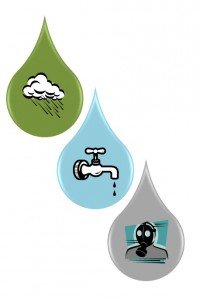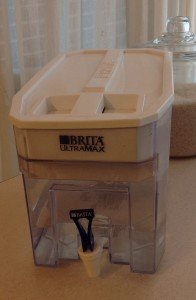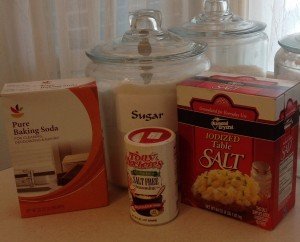
While we can’t ship our water directly to those in need, we can ship goods that would require water affected locations don’t have. We can also create demand for products that use less water, making it possible for individuals to make economic decisions that allow them to use water more wisely.
The power of the consumer “vote” is unquestioned. Every bite you eat and drop you drink shapes the world your brothers and sisters are forced to live in.
In celebration of an awesome batch of soy milk, I would love to share some options for drinking that are both water-wise and suited for food storage.
Water – the best drink there is (one cup consumed per cup)

So if you were a 108 pound teenage girl, you would want to drink 54 ounces of water per day (almost 7 cups). If you were a 320 pound man, you would want to drink 160 ounces of water per day (20 cups).
Alas, most of us do not have room to store a year’s supply of potable water (roughly 300 gallons per person, depending on what you need to cook).
Enter aquaponics. I’m about to install an new aquaponics garden (~10′ x 18′) in the back yard of my townhome. The system will hold 1000 gallons of water, between the fish tank, filter tanks, grow bed, and sump tank. On a day to day basis, I’ll pop out back, feed the fish, harvest some greens, and come back inside. All done with “gardening” in less than 5 minutes per day.
But in case of an emergency where we have long-term lack of potable water, I could transform the water from that garden to potable water using standard distillation techniques. I’m particularly interested in a solar distillation system where I’d just fill up a glass baking pan in a solar box. The water would evaporate, condense on the tilted glass “lid,” then bead down and collect in a container.
Voila, water enough to keep a body healthy for over a year (speaking of me and a couple of close friends, even in the event of near-total drought).
If there were an extended shortage of water, there would also likely be an extended shortage of commercial food. Here again the garden produce is a brilliant addition to the wheat, beans, and other dry goods I might have stashed in long-term storage. A bit of basil, oregano, thyme, chives, and other greenery goes a long way to making things palatable, not to mention providing necessarily vitamins.
Hydration Solution (50 cups consumed per cup)

She died.
Too much pure water without salts and sugars can leach important minerals from your body, causing you to become very ill or even die. Illnesses such as cholera that cause you to lose lots of water can also be fatal. Diarrhea and vomiting due to any cause can be quickly fatal, particularly in young individuals. Ebola is more rare than “regular” diarrhea and vomiting, but has a much higher mortality rate. For all these diseases, Oral Rehydration Solution (ORS) is critical. Outbreaks of diseases like cholera and Ebola could cause commercial stores to become unavailable for an extended period of time. So this is a remedy you want to have immediately available.
You’ll want a good portion of sugar, a decent amount of salt, and a bit of potassium. Luckily, sugar, salt, and salt substitutes are inexpensive, readily available, and easy to put into long term storage. There are various recipes for ORS, but I like this one from the World Health Organization:
World Health Organization ORS Recipe
Shared by Darlene Kelly, MD and Joe Nadeau, RPh
Ingredients:
– 3/8 tsp salt (sodium chloride)
– ¼ tsp Morton® Salt Substitute® (potassium chloride)
– ½ tsp baking soda (sodium bicarbonate)
– 2 tbsp + 2 tsp sugar (sucrose)
– Tap water to make one (1) liter
– Optional: Nutrasweet® or Splenda® based flavoring of choice, to taste
Directions:
1. Add the dry ingredients to a 1 liter bottle.
2. Add enough water to make a final volume of 1 liter; mix well.
3. If desired, add Nutrasweet® or Splenda® based flavoring, to taste. Mix well.
4. Sip as directed by your physician.
5. Keep chilled in the refrigerator for best taste. Discard after 24 hours.
Contains 27 grams of sucrose, 70 mEq per liter of sodium, 20 mEq per liter of potassium and 30 mEq per liter of bicarbonate. The final osmolarity is approximately 245 mOsm per liter.
Soy Milk (600 cups consumed per cup)
Ingredients:
– 1 cup dried soy beans (not the green edamame beans)
– 1 gallon of water (includes rinsing water)
– 3 tbsp sugar
– ½ tsp salt
Directions:
1. Soak the beans in 2 cups water for 8 hours (no more than 24 hours).
2. Microwave the soaked beans and water for 3 minutes (alternately blanche for 5 minutes on the stove).
3. When cool enough to touch, rub the beans to loosen the hulls from the beans.
4. Pour the water from the container. Add fresh water, agitate the beans, and pour again. Repeat until the hulls are all gone (they will be the first things to pour out with the initial water).
5. Add the beans to 4 cups of water in a heavy-duty blender. Puree for a minute.
6. Drain the uncooked milk and add to a large stock pot, leaving behind the solids (okara). If you have a jelly strainer with a cheese cloth bag, you’ll find this to be downright pleasurable.
7. Add the okara to 3 cups of water in the blender. Puree for a minute.
8. Drain the uncooked milk into the stockpot, leaving behind the okara.
9. Add the okara to 2 cups of water in the blender. Puree for a minute.
8. Drain the uncooked milk into the stock pot, leaving behind the <em>okara</em>.
9. Bring the milk to a simmer and heat for 15 minutes.
10. Bring to a boil. The milk will foam up (make sure it’s a large stock pot). You can prevent the foam from overflowing the container by smoothing an layer of shortening around the rim, roughly one inch wide (the foam will ‘pop’ when it meets the shortening).
11. Reduce heat and continue to simmer for 20 minutes, scraping the bottom and sides to prevent a film from forming and burning.
12. While still hot, mix in the sugar and salt. You’ll end up with roughly 2½ quarts of milk.
13. Allow to cool, then keep chilled in the refrigerator for best taste. Will keep for a couple of days if covered.
You could add vanilla, but vanilla requires a lot of water to grow. For example, the water required to grow the vanilla for a cup of soda is more than twice as much as the water to grow the sugar for that same cup of soda. So if you don’t mind the milk with just the sweetness of sugar, skip the vanilla.
At three cups a day, this should last a family of three a day for drinking and adding to recipes. Remember we’re talking about food storage for emergencies. Like Sunday. And when you realize there’s no money and the milk is gone. Or you find out some idiot stole millions of credit/debit card numbers from a popular retail chain and your bank has disabled all your plastic (and you’re out of milk or it’s Sunday).
Note that the okara makes a great addition to home-made bread. Add about 1/2 cup of the stuff to your regular ~4 cup bread recipe, increasing the flour amount to 5 cups. The okara will not only increase the nutritional value of the bread, but will keep the bread from getting stale so quickly.
Kombucha (300 cups of water consumed per cup)
In addition, kombucha contains all kinds of probiotic goodness. And the yeast in the icky-looking thing that transforms the tea to kombucha provides a certain level of B vitamins.
Unfortunately, commercial kombucha is made from regular tea leaves. Assuming you’re Mormon and don’t actually want to be storing black tea or making a beverage that contains caffeine, this can be a problem.
Luckily, it is possible to make a good kombucha with the leaves of the red rooibos bush and the related honeybush. Like all the drinks mentioned in this post, the main ingredients can be kept in food storage.
I recommend a spigoted glass or ceramic container for your kombucha. With this method, you simply add a couple of quarts of cooled sweet rooibos tea every time you’ve drained the main container by a couple of quarts. This way you have minimal mess and a continual supply of kombucha to drink as desired. (In a pinch, you can use the stuff in lieu of vinegar to clean with – awesome!)
Tools Recommended:
– Pot for boiling water
– Glass pitcher for steeping tea
– Glass or ceramic beverage container with plastic spigot (preferably not chromed)
– Re-usable mesh coffee filter
– Optional: thermometer
Ingredients:
– a symbiotic colony of bacteria and yeast (SCOBY) for making kombucha
– at least a cup of mature kombucha (you can use apple cider vinegar in a pinch)
– 8 cups of water
– 1 T loose rooibos/honeybush tea
– ½ cup sugar
Directions:
1. Add a cup of water to the pitcher. This will spread out the thermal shock when you add the hot water later. Or you can take your chances with whether the pitcher shatters and sends boiling water all over your kitchen.
2. Add the loose tea and sugar to the pitcher.
3. Bring the remainder of the 8 cups to a boil.
4. Pour the boiling water into the pitcher.
5. Stir to ensure the sugar and tea isn’t clumped at the bottom.
6. Cover and let the sweet tea cool to 90 degrees (mildly warm to the touch). It can be room temperature, you just don’t want it so hot it might damage the SCOBY.
7. Pour the cooled sweetened tea through the coffee filter into the container with the SCOBY and mature kombucha. A re-usable coffee filter should remove all the solids, keeping your SCOBY from looking even more frightening than it already does and reducing the likelihood of mold growth.
8. Keep covered with a fine-weave cloth. This keeps out dust and bugs that could contaminate the SCOBY with mold spores.
9. When the taste migrates from sweet to tangy, it’s transformed from sweet tea to kombucha (this will take roughly a week for the first batch, a day if you are merely maintaining a largish spigoted container of kombucha).
In warmer weather, the maturation of the kombucha will occur more quickly, in winter it will take longer.
If the somewhat disgusting-looking SCOBY starts growing mold, discard it and all the kombucha in the container. Since SCOBYs replicate, you’ll find you’re able to share with friends all too quickly.
Kombucha does come about because of fermentation, but the residual alcohol is so minimal that kombucha does not meet the criterion for being an alcoholic beverage. Whereas orange juice left out on the kitchen counter well could meet that criterion. The awesome thing is that you can have a beverage with a complex-flavor that doesn’t require refrigeration and provides beneficial bacteria.
All of these beverages require relatively little water to “make,” with pure water being the best of the bunch.